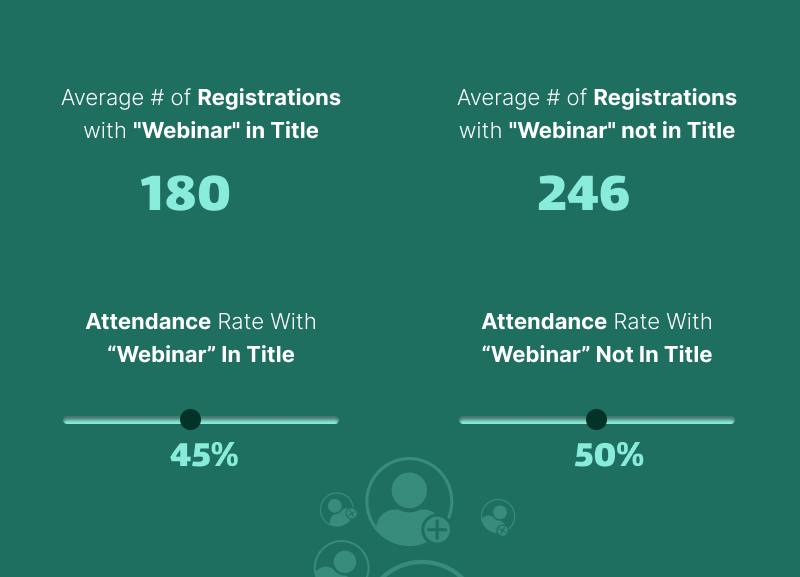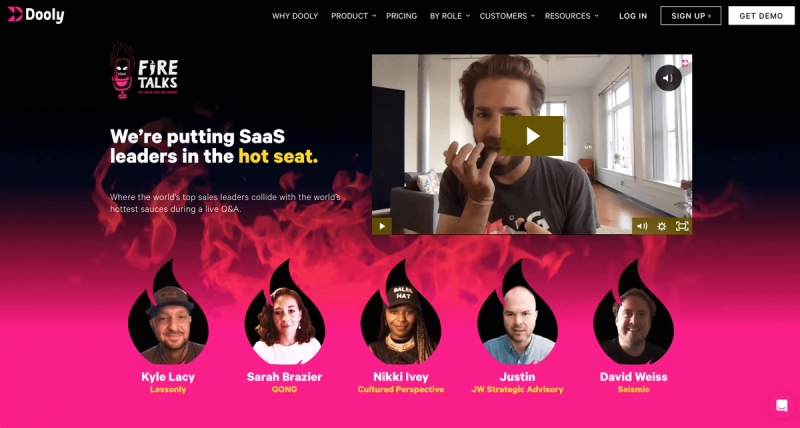What’s in a Name? Improve Your Webinar Registration Rate With These 3 Tips

Maximize Your Marketing ROI
Join 10,000 other marketers already getting the best tips on running engaging events that boost pipeline and create raving fans.
As marketers, it's natural to focus on the content of your digital events. For example, you might be busy searching for the best, coolest speakers around or accumulating super awesome swag to give away at your next webinar.
All of that makes total sense, but there's an often-overlooked component of driving people to register for your events—your webinar title.
Now that we've said it, it probably seems almost too obvious, right? Of course, the title matters! It's a person's first impression of your event and (hopefully) lets them know exactly what they can expect from it. It's a chance to grab interest, spark curiosity, and push people to learn more.
So, how can you come up with catchy webinar titles that maximize registration? To answer that question, we've pulled these three tips from our recent B2B Webinar Benchmark Report to share with you! Read on to discover how to transform your event naming process.
Tip #1: Don’t use the word “webinar”
No burying the lead here; our number-one tip is to avoid using the word "webinar" to name events if you can.
This one was definitely the most shocking insight pulled from this year's report. It sounds almost counterintuitive because oftentimes, our goal is to be clear and direct with our audience.
However, the numbers don't lie. We looked at 426 webinar titles and found that there was actually a 50% drop in registration when people saw the word "webinar" in the event name.

We mulled this data over for a while, and right now, we think that the dropoff in registrations could be related to Zoom fatigue. To be frank: Webinars have gotten a bad rap, especially over the last couple of years. People are conditioned to think "work" or "long meeting" or maybe even "time-waster" when they see the word "webinar."So, if we aren't gonna call our webinars "webinars," what are we going to call them?

🔥 Dooly has a spicy webinar series called Fire Talks. Instead of simply calling them “webinars” or “interviews,” Dooly opted for a clever name that matches the theme of the series. Each episode features unfiltered conversations with sales leaders as they sample the world’s spiciest sauces.
The solution here is to get creative. Show people right off the bat that you aren't just another webinar event. Think about the value that your event is going to provide attendees and brainstorm copy that supports that. You can also ask yourself, "What would I call this event if it were a blog post?" to try to come up with ideas.
Here's a quick list of some alternatives to the word "webinar":
- Workshop
- Masterclass
- Training
- Office Hours
- Fireside Chat
- [XYZ] Hour
- [XY] Chat
- Basics of…
- 101, 201, etc.
- Deep dive
- Series: If you're running a recurring event, consider branding it and leading it with that title for all of the webinars
And this is just a start! We've seen our clients come up with some spectacular titles for their webinars. If you want more inspiration, download our full report!
🔥 Want more data-driven webinar tricks? Check out our full Webinar Benchmark Report!
Tip #2: Be specific
Now that we know what not to do, we'll move on to our next tip, which is to be specific. You only have a few seconds (if that) to snag someone's attention, and you definitely don't want people to see your title and wonder, "Hmm…What's that supposed to be about?"
The best webinar names are creative but still get right to the point. You want to convey what people should expect so that you're drawing the right audience to your event.
Allow us to be more, well, specific. Here are three tactics you can use:
- Use numbers in your title. For example, "7 Data-Backed Trends to Drive Your Sales Strategy" tells people exactly what they're going to walk away with if they attend your event. So does "5 Tips For Aligning Sales and Marketing Teams." You can see how both of these are stronger titles than "Sales Improvement Webinar," which is vague and pretty uninteresting at first glance!
- Include your target audience in the name. If you're looking to recruit marketing managers to your event, let 'em know! Call your webinar "A Marketing Manager's Guide to Scaling Digital Teams," and they'll know exactly why they should sign up.
- Designate the learning level. If there are different levels of expertise associated with your content, call that out. For example, if this is a 200-level course versus a beginner-level or more advanced level, use that in the name: "Cold Calling 201: What Seasoned Salespeople Should Know."
Tip #3: Be clear about the WIIFM
If you're unclear about WIIFM, don't worry—we'll break it down right now.
WIIFM = "What's in it for me?," and it's a question that every single person who sees your event will be asking themselves.
In other words: What will someone get by taking time out of their day to attend your webinar?
People only sign up for things if they need or want something from them. So, if they feel they will gain something valuable from your webinar—whether that's connection, education, or answers to questions—they will sign up.
“WIIFM = ‘What's in it for me?’ In other words: What will someone get by taking time out of their day to attend your webinar?”
Use powerful words here. Again, be specific and not generic. Reflect on the value you bring and the pain points or problems that your audience has that you'll be speaking to. Your content must be relevant to resonate with them, so this is a good time to check in and make sure that's true!
A "how to" format can work really well here. Here are a few examples of powerful titles that clearly communicate the value of your event:
- How to Become a 10x People Manager Without Burning Out
- 6 Strategies for Moving the Needle on DE&I Initiatives
- How to Scale Your Digital Events Strategy in 2023
- 3 Ways to Crush Your e-Commerce Revenue Goals
And, of course, be sure you deliver on what you promise in your title. If you told them you'd teach them how to move the needle on diversity, for example, be sure that you actually do that.
Ready for all the webinar tips and tricks?
Now that you know how to scheme up some more creative event titles, what else can you improve on before your next event? Find out with Webinar Week, a free series where we share behind-the-scenes tips we’ve learned after hosting more than 100 digital events.

Transform Your Video Marketing with AI
Stay In Touch
Platform
Resources
© 2025 Copyright Goldcast, Inc. All rights reserved.





 Upcoming Events
Upcoming Events Event Series
Event Series On-Demand Events
On-Demand Events

